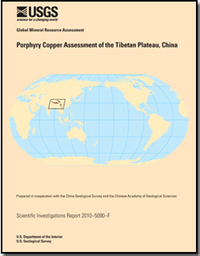Porphyry copper assessment of the Tibetan Plateau, China: Chapter F in Global mineral resource assessment
Links
- More information: USGS Index Page
- Document: Report
- Larger Work: This publication is Chapter F of Global mineral resource assessment
- Metadata: Metadata
- Spatial Data: Spatial Data
- Download citation as: RIS | Dublin Core
Abstract
The U.S. Geological Survey collaborated with the China Geological Survey to conduct a mineral-resource assessment of resources in porphyry copper deposits on the Tibetan Plateau in western China. This area hosts several very large porphyry deposits, exemplified by the Yulong and Qulong deposits, each containing at least 7,000,000 metric tons (t) of copper. However, large parts of the area are underexplored and are likely to contain undiscovered porphyry copper deposits.
Three tracts were delineated as permissive for porphyry copper deposits on the Tibetan Plateau—the Yulong (Eocene and Oligocene), Dali (Eocene through Miocene), and Gangdese (Oligocene and Miocene) tracts. The tracts were defined based on mapped and inferred subsurface distributions of igneous rocks of specific age ranges in which the occurrence of porphyry copper deposits is possible. These tracts range in area from about 95,000 to about 240,000 square kilometers. Although maps of different scales were used in the assessment, the final tract boundaries are intended for use at a scale of 1:1,000,000.
The deposits on the Tibetan Plateau all formed in a post-subduction environment, one newly recognized as permissive for the occurrence of porphyry copper deposits. Based on the grade, tonnage, and geologic characteristics of the known deposits, two tracts, Yulong and Gangdese, were evaluated using the general (Cu-Mo-Au) porphyry copper grade and tonnage model. The Dali tract was evaluated using the gold-rich (Cu-Au) submodel. Assessment participants estimated numbers of undiscovered deposits at different levels of confidence for each permissive tract. These estimates were then combined with the selected grade and tonnage models using Monte Carlo simulation to generate quantitative probabilistic estimates of undiscovered resources. Additional resources in extensions of deposits with identified resources were not specifically evaluated.
Assessment results, presented in tables and graphs, show mean expected amounts of metal and rock in undiscovered deposits at different quantile levels, as well as the arithmetic mean for each tract. This assessment estimated a mean of 39 undiscovered porphyry copper deposits within the assessed permissive tracts on the Tibetan Plateau. This represents nearly four times the number of known deposits (11) already discovered. Predicted mean (arithmetic) resources that could be associated with the undiscovered deposits are about 145,000,000 t of copper and about 4,900 t of gold, as well as byproduct molybdenum and silver. Reliable reports of the identified resources in the 11 known deposits total about 27,000,000 t of copper and about 800 t of gold. Therefore, based on the assessments of undiscovered Tibetan Plateau resources in this report, about six times as much copper may occur in undiscovered porphyry copper deposits as has been identified to date.
Study Area
| Publication type | Report |
|---|---|
| Publication Subtype | USGS Numbered Series |
| Title | Porphyry copper assessment of the Tibetan Plateau, China: Chapter F in Global mineral resource assessment |
| Series title | Scientific Investigations Report |
| Series number | 2010-5090 |
| Chapter | F |
| DOI | 10.3133/sir20105090F |
| Year Published | 2012 |
| Language | English |
| Publisher | U.S. Geological Survey |
| Publisher location | Reston, VA |
| Contributing office(s) | Eastern Mineral and Environmental Resources Science Center, Mineral Resources Program |
| Description | Report: viii, 63 p.; Metadata folder; GIS data zip package |
| Larger Work Type | Report |
| Larger Work Subtype | USGS Numbered Series |
| Larger Work Title | Global mineral resource assessment (Scientific Investigations Report 2010-5090) |
| Country | China |
| Other Geospatial | Tibetan Plateau |
| Projection | Asia North Albers Equal Area |
| Online Only (Y/N) | Y |
| Additional Online Files (Y/N) | Y |


